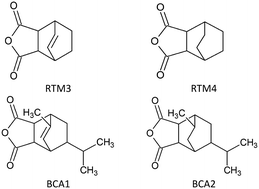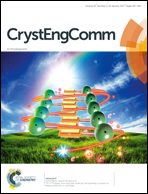Unusual physical behaviour and polymorphic phase transitions in crystalline bicyclic anhydrides†
Abstract
Bicyclic anhydrides function as versatile building blocks for polymeric materials, but molecular crystals of these monomeric units demonstrate interesting physicochemical properties. Here, we investigate two pairs of crystalline bicyclic anhydrides, where each pair contains a saturated and unsaturated component. One pair (RTM3/RTM4) is built around bicyclo[2.2.2]octane-2-endo,3-endo-dicarboxylic acid anhydride (BA) and another pair (BCA1/BCA2) consists of a BA-core with alkyl substituents. Differential scanning calorimetry (DSC), powder X-ray diffraction (PXRD) and reflective melting point determination shows that both components in the RTM3/RTM4 pair undergo reversible, polymorphic temperature-induced phase transitions to the same space group while the BCA1/BCA2 pair does not. The melting point (MP) behavior of the BCA1/BCA2 pair is interesting because it contradicts typical alkane/alkene MP trends, as the un-saturated component (BCA1) has the higher MP. Lattice enthalpies calculated via dispersion inclusive density functional theory (DFT+vdW) help to elucidate this unusual MP behavior. In addition, Hirshfeld surface analysis of both pairs demonstrates that variations in the intermolecular close contacts may have an effect as to whether the saturated or unsaturated component will exhibit the higher MP. Finally, BCA1 is found to possess unique liquid–solid phase transition properties for a single component organic molecular crystal (OMC), as it is supercoolable over a ∼60 K range.


 Please wait while we load your content...
Please wait while we load your content...